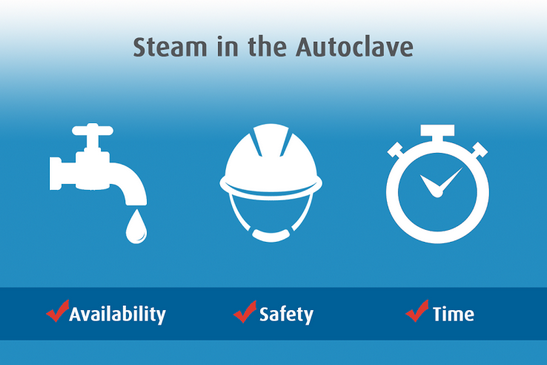Chemical disinfectants used in healthcare environments eliminate a wide range of bacteria; however they do not destroy or kill spores. A spore[i] is a form of bacteria which has been found resistant and adopted by a bacterial cell in harmful conditions (such as bacterial nutrient deprivation). The process to eliminate spores is difficult compared to killing other ranges of bacteria and pathogens, as spores are able to survive increased temperatures (100 ºC – boiling point). The elimination process of spores can be achieved through a process of steam sterilization – i.e. autoclaving.
Why is steam the preferred method for killing micro-organisms?
One of the most effective ways to transfer heat energy is via humidity, contained within steam. Moist heat (steam) is proven to be more effective than dry heat for killing a wide range of micro-organisms due to its ability to penetrate microbial cells. This type of heat energy kills micro-organisms by denaturing their proteins which causes a loss of the proteins three-dimensional functional shape[i]. Think of a wound caused by boiling water or water vapor versus a wound caused by being exposed to dry heat. The wound that resulted from moist heat will hurt more and go much deeper than the one caused by dry heat.
Due to the increase of pressure and steam generation within an autoclave, this allows for the temperature within the chamber to reach above boiling point (100 ºC) and allow for the elimination of a wider range of micro-organisms (including bacterium spores). To eliminate bacterium spores and all micro-organisms, the temperature needed should be above 130ºC for quick a sterilization cycle (5 minutes) or above 120ºC for a longer sterilization cycle (20-30 minutes). [ii] Exposing the micro-organisms to a high temperature with a short timing cycle, or under a low temperature with a longer timing cycle will both be effective in eliminating the micro-organisms, as there is only a specific amount of time all bacterium can survive under these temperature conditions.
In this article we will discuss the three main reasons and benefits why steam is the preferred method recommended by the ADA and is mandated by Australian standards. These reasons being:

Availability
Steam is widely available since there are only two ingredients needed: water and a source of heat. Since every surgery in Australia and New Zealand has and must have access to water, it follows that finding water for operating the autoclave is reasonably likely and reliable. In addition to being available, steam is also cost-effective. Since the steam sterilizer, or autoclave, does not require the use of any other chemicals, it’s relatively inexpensive to operate.
Autoclaves require water to generate steam; however, tap water is not the appropriate option. Tap water[i] contains a wide range of minerals and impurities which have the capacity to abort your autoclave cycle, and over time will calcify the internal chamber and components, leading to increased maintenance. The safer option to preserve the longevity of your autoclave is to use or connect a Reverse Osmosis filter to your tap water feed, or to purchase distilled/demineralized water. However, comparing the long term cost of a Reverse Osmosis filter and purchasing distilled water – the RO system works out to be less expensive to operate in the long run (requiring minimal maintenance, once every 12 months). This system allows for the water to be purified and therefore improves the life of the equipment.
Safety
Unlike many other sterilizing agents, steam is non-toxic. Since steam is a form of water vapor produced by boiling, and essentially has the same properties of water. However, one should always take precautions to not get burnt by hot steam. As steam is a form of water vapor and there is no extra chemicals required, this eliminates the need for storage of hazardous chemicals.
Cycle Time
Steam (moist heat) is able to strike micro-organisms faster than dry heat, and that’s due to steam being able to transfer heat faster than hot air. For example, it takes two hours at 160ºC to kill bacterium spores under dry heat, whether as steam will have all micro-organisms eliminated within five minutes at 134ºC due to the denaturing of the micro-organism proteins. Therefore, steam or moist heat requires a shorter sterilization time in comparison with dry heat.
Recap
We applied our new understanding of steam to explore why it’s the most effective agent for the sterilization of medical instruments.
- First, we explained that steam is easily accessible, both in its availability and its low cost – in conjunction with a Reverse Osmosis filter to draw out any impurities within the water to increase the longevity of the autoclave.
- Second, steam is likely the safest option since it is non-toxic and requires no chemicals. However, one should always take caution when operating the autoclave due to hot heat.
- And finally we discussed how steam efficiently transfers heat energy via humidity to the load inside the autoclave, therefore being able to achieve sterilization faster compared to dry heat.
Now that we understand why steam is the most effective agent for sterilizers, it’s time to learn more about the basic processes of autoclaves. Stay tuned for the next post in this series, which will take you deeper into the how’s and why’s of tabletop autoclave operation.
Autoclave Sterilisation series previous articles:
Part 1 - Microbiology and the Spread of Germs
Part 2 - Preventing the Spread of Infection in Dental Practices
Part 3 – What is an Autoclave?
Part 4 – Basic Concepts of Steam
Check out the Autoclave Sterilisation Basics series from the Sterilisation and Infection Control blog by Tuttnauer.
[1] https://www.dentalpurity.com/distilled-water-for-autoclaves/
[1] http://time.com/4438396/russia-anthrax-siberia-outbreak-infected-spores/
[1] https://micro.cornell.edu/research/epulopiscium/bacterial-endospores
[1]https://gibraltarlabsinc.com/difference-between-moist-heat-sterilization-dry-heat-sterilization/
[1] https://www.cdc.gov/infectioncontrol/guidelines/disinfection/sterilization/steam.html
[1] https://www.dentalpurity.com/distilled-water-for-autoclaves/
[i] https://micro.cornell.edu/research/epulopiscium/bacterial-endospores
[i]https://gibraltarlabsinc.com/difference-between-moist-heat-sterilization-dry-heat-sterilization/
[ii] https://www.cdc.gov/infectioncontrol/guidelines/disinfection/sterilization/steam.html
.png)


